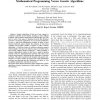799 search results - page 37 / 160 » Function Sequence Genetic Programming |
GECCO
2009
Springer
14 years 10 days ago
2009
Springer
The notion of evolvability has been put forward to describe the“core mechanism”of natural and artificial evolution. Recently, studies have revealed the influence of the envi...
CORR
2006
Springer
13 years 7 months ago
2006
Springer
Abstract. Support Vector Machines (SVMs) are well-established Machine Learning (ML) algorithms. They rely on the fact that i) linear learning can be formalized as a well-posed opti...
CEC
2010
IEEE
13 years 5 months ago
2010
IEEE
The great majority of genetic programming (GP) algorithms that deal with the classification problem follow a supervised approach, i.e., they consider that all fitness cases availab...
CEC
2009
IEEE
14 years 2 months ago
2009
IEEE
— Genetic algorithms (GAs) have been argued to constitute a flexible search thereby enabling to solve difficult problems which classical optimization methodologies may find ha...
BMCBI
2006
13 years 7 months ago
2006
Background: The functional annotation of proteins relies on published information concerning their close and remote homologues in sequence databases. Evidence for remote sequence ...


